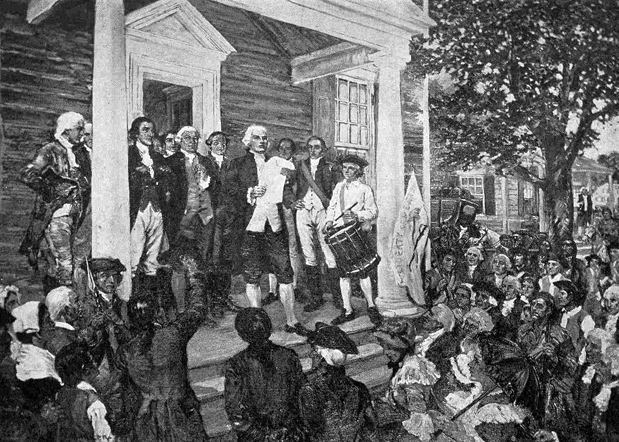On the afternoon of July 9, 1776, at the Court House in White Plains, Colonel Pierre Van Cortlandt voted to approve the Declaration of Independence. He was one of eleven deputies from Westchester County at the meeting of “the Provincial Congress of the Province of New-York.”1

Convention of Representatives of the State of New York, after their meeting of July 9, 1776.
Courtesy of the Westchester County Archives.
The meeting took place at a time of high drama. As the Continental Congress was meeting in Philadelphia to declare independence (on July 2) and to approve the text of the declaration (on July 4) the British were assembling, in the harbor in New York City, what historian Wilbur C. Abbott called “the most formidable force yet used by any European power outside of Europe.”2
“On July 2,” he wrote, “they were in the harbor; and even while the Declaration of Independence was being adopted, the army which was designed to make independence impossible was being disembarked on Staten Island . . . It was enough to give the hardiest patriot pause. A hundred and thirty vessels, carrying six thousand veterans from Halifax; troops from the British garrisons in the West Indies, Gibraltar, and the British Isles, and eight thousand seasoned soldiers from Germany, well-officered and well-supplied, experienced in war, supported by a fleet—such was the great argument presented by the British government against a hasty decision by New York in favor of independence.”
New York’s decision on independence was crucial, not only because of the size and strategic importance of the colony, but because New York’s delegation in Philadelphia—lacking instructions from the Provincial Congress—had been the only delegation to abstain from the July 2 independence resolution—preventing the vote from being unanimous.
The Provincial Congress began the July 9 meeting in the morning by electing officers. They then allowed deputies from New York, Albany and Orange counties “take their seats”, but asked that they take measures to procure a copy of their missing “Credentials.” They also took “the general oath of secrecy”—with the exception of Mr. Benjamin Smith, who “refused to take the oath” and “accordingly withdrew.”
After dispensing with other business “a Letter from the Delegates of the Colony at Continental Congress of the 2nd July . . . on the subject of Independence, and requesting Instructions from this Congress, was received and read.”
Because events had been moving quickly they then read a second letter from the delegates in Philadelphia—this one “enclosing the Declaration of Independence,” the full text of which they recorded in the minutes. The letters and the Declaration were then referred to a committee chaired by John Jay.
When the Provincial Congress reconvened that afternoon “the Committee appointed to take into consideration the letter from our Delegates in Continental Congress, and the Declaration of Independence, reported the following, which was unanimously agreed to, and is in the words following, that is to say:
In Convention of the Representatives of the State of New-York, White Plains, July 9, 1776.
Resolved, unanimously, That the reasons assigned by the Continental Congress for declaring the United Colonies free and independent States, are cogent and conclusive; and that while we lament the cruel necessity which has rendered that measure unavoidable, we approve the same, and will, at the risk of our lives and fortunes, join with the other Colonies in supporting it.”
The Representatives (of what they now referred to as the State of New-York) also resolved that the Declaration of Independence be published “to the beat of a drum” in White Plains and throughout the “State of New-York.”
They finished by resolving that “the Delegates of this State in Continental Congress, be, and they are hereby, authorized to consent to and adopt all such measures as they may deem conducive to the happiness and welfare of the United States of America.”
The Westchester County Archives has graciously allowed us to use an image of their exceedingly rare copy of the broadside, printed in New York City by John Holt as a result of the July 9 resolution.3 The Provincial Congress ordered that 500 copies be printed and “sent to all the County Committees in the State.” Today, there are only five known copies.4
There is one significant word missing from this and all the other July 1776 broadsides and newspaper printings. When the engrossed copy of the Declaration was made on vellum in early August5, 1776, the heading was changed as a result of the actions Pierre Van Cortlandt and the other patriots took in White Plains. The heading of the vellum copy reads “The unanimous declaration of the thirteen United States of America.”

- All quotes from the minutes of the July 9 meeting are from Peter Force’s American Archives, volume 1, fifth series, pages 1385-1392. ↩
- Abbott, Wilbur Cortez. New York in the American Revolution. New York, London: C. Scribner’s Sons, 1929. ↩
- Holt also printed the Declaration as a full-page in the July 11 issue of his newspaper, the New-York Journal. The opposite page had a note which read “The Declaration of the United States of America, is inserted in this paper . . . to oblige a number of our Customers, who intend to separate it from the rest of the paper, and fix it up, in open view, in the Houses, as a mark of their approbation of the INDEPENDENT SPIRIT of their Representatives.” ↩
- Three other copies are at the New York Public Library, the Huntington Library and the Cincinnati History Library and Archives. An additional copy is in private hands. ↩
- It was not signed on July 4th and some signatures were not added until years later. ↩
That was a fantastic find. Can’t wait to share it.
I AGREE WITH MARIA!!!!!